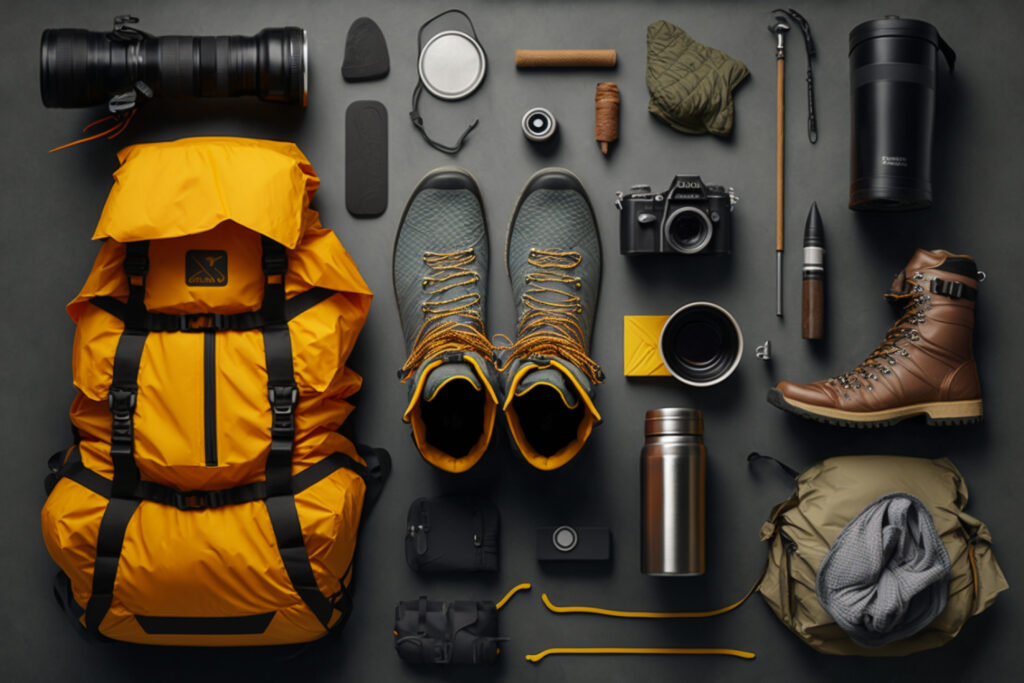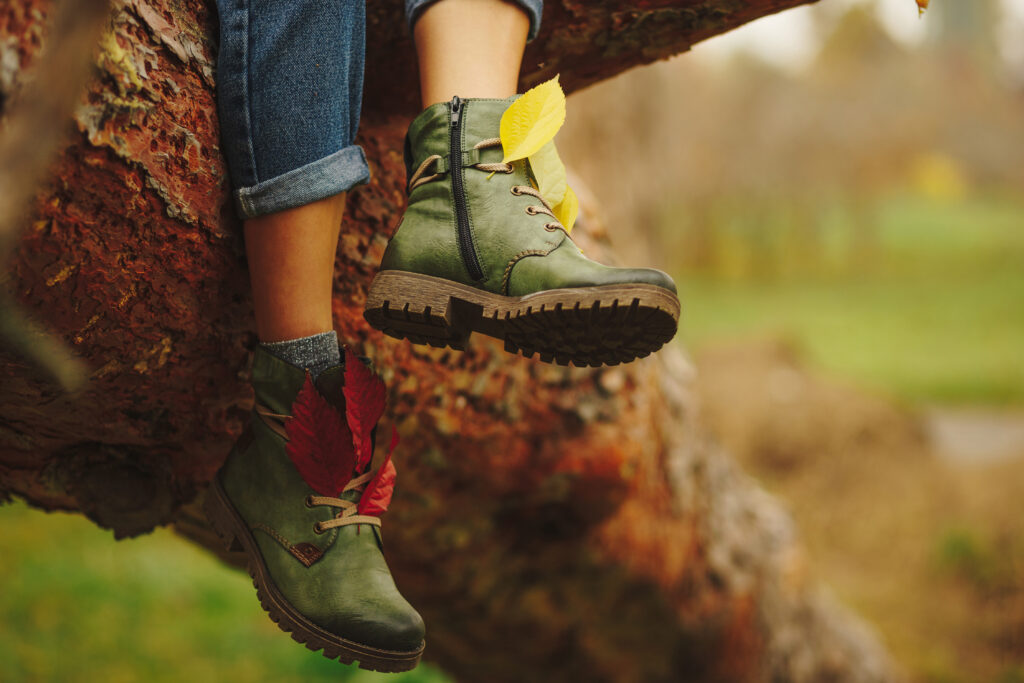INTORDUCTION
Choosing the right shoes for hiking is essential to having a relaxing, risk-free, and joyful outdoor experience. More than just a fashion statement, hiking boots are a need for offering protection, stability, and support on a variety of terrains. New developments and fashions in hiking boots are reshaping the outdoor gear market as we go into 2024. This thorough book explores the nuances of hiking boots, covering everything from knowing the various kinds and characteristics to making an informed choice and caring for your boots to extend their lifespan.
An Overview of Boots for Hiking
Specialized footwear made to endure the challenges of outdoor paths and offer the support required for various hiking activities is known as hiking boots. They are designed to withstand a variety of surfaces, including snow-covered summits, muddy pathways, and rocky paths. To choose the best pair and improve your entire hiking experience, it’s essential to comprehend the functions and advantages of hiking boots.
The Significance of Best Hiking Boots
• Protection: Your feet are protected by hiking boots from sharp items, unforgiving terrain, and inclement weather.
• Support: They provide vital support for your ankles and arches, reducing the risk of weariness and injury.
• Traction: Hiking boots with cutting-edge outsoles offer superior stability and grip on a variety of terrain.
• Comfort: During lengthy hikes, wearing appropriate hiking footwear improves comfort by cushioning your feet and lessening impact.
Hiking Boots Types
Your hiking style, the terrain, and the length of your journeys will all influence the kind of hiking footwear you should buy. A summary of the several types is given below:
Boots for Day Hiking
Day hiking boots are perfect for day outings on less strenuous terrain because they are made for short to moderate walks. For short excursions, these boots provide sufficient comfort and support because they are usually lighter and more flexible.
Important attributes:
• Lightweight Design: Suitable for long walks and easier to wear.
• Moderate Ankle Support: Offers sufficient assistance without being unduly limiting.
• Comfortable cushioning: guarantees ease on quick hikes.
Hiking Boots
Meindl hiking boots are ideal for multi-day excursions and long journeys with hefty loads. They are appropriate for rough and uneven terrain because they provide exceptional protection, support, and durability.
Important attributes:
• Improved Ankle Support: A deeper cut to safeguard and uphold the ankle.
• Sturdy Materials: Constructed with resilient materials to resist harsh environments.
• Robust Outsoles: Made to withstand bulky backpacks and uneven terrain.
Boots for Mountaineering
Mountaineering boots are made for severe weather and climbing at high altitudes. For ice and snow climbing, they are sturdy, insulated, and frequently compatible with crampons.
Important attributes:
• Sturdy Construction: Offers stability and support on snowy and hilly terrain.
• Insulation: Provides warmth for feet in icy weather.
• Crampon Compatibility: Permits ice climbing with crampon attachment.
Approaching Sneakers
Intended for tricky approaches to climbing routes, approach shoes are a cross between Merrell hiking boots and climbing shoes. Their comfort, grip, and flexibility are all well-balanced.
Important attributes:
• Climbing Shoe-Like Grip: Offers superior traction on jagged terrain.
• Lightweight and flexible: Promotes comfort and ease of movement.
• Versatile Design: Fits a variety of surfaces and uses.
Crucial Elements of Mountain Boots
Knowing the essential characteristics of hiking boots will enable you to make a well-informed decision. Here are some points to consider in further detail:
Comfort and Fit
Hiking Boots must fit and feel comfortable in order to be enjoyable. A properly fitting boot reduces the possibility of blisters, soreness, and tired feet.
Vital Elements:
• Appropriate Sizing: Make sure the boots are well-fitting across the arch and heel, leaving adequate room in the toe box.
• Arch Support: To ensure correct foot alignment, look for boots with sufficient arch support.
• Cushioning and Padding: Sufficient cushioning and padding improve comfort, particularly on lengthy hikes.
Durability and Assistance
In uneven terrain, support and stability are essential for reducing injuries and improving performance. The amount of support offered by various LOWA hiking boots varies:
Support Types:
• Ankle Support: Higher-cut boots offer superior ankle support, which lowers the possibility of sprains.
• Midsole Support: A stable, well-cushioned midsole reduces shock.
• Lateral Support: Assists in preserving equilibrium over rough terrain.
Outsoles and Traction
Your hiking boots’ outsole is extremely important for stability and traction. Select boots with premium outsoles made for varying types of terrain.
Important characteristics:
• Tread Pattern: For improved grip, search for deep lugs and multidirectional patterns.
• Rubber Quality: Reliable traction and longevity are ensured with robust, abrasion-resistant rubber.
• Heel Brake: For increased stability when descending, many boots have a heel brake.
Water resistance and airflow
For comfort and safety, Waterproof hiking boots usa that are breathable and vital, as weather conditions might change greatly.
Aspects to Take Into Account:
• Waterproof Membranes: Gore-Tex and other materials offer waterproof defense while letting moisture out. Breathable fabrics improve comfort by controlling body temperature and reducing perspiration.
• Seam sealing: makes sure that gaps allow water to seep in.

Flexibility and Weight
Your comfort and range of motion are impacted by the hiking boots’ weight and flexibility. Various boots meet different needs:
Weight-Related Issues:
• Lightweight Boots: Perfect for easy terrain and day treks.
• Hefty-Duty Boots: Suitable for rugged terrain and hauling hefty weights.
Adaptability
• Flexible Boots: Ideal for shorter excursions, these boots provide more mobility.
• Stiff Boots: These offer more support and work well on rough terrain.
- 2024’s Top Models and Brands
Numerous companies are well-known for manufacturing excellent Hiking Boots. Here are a few popular models and brands to look out for in 2024:
Highlights of the Brand
• Salomon: Known for their cutting-edge designs and technologies, Salomon provides a selection of hiking boots fit for various conditions and pursuits.
• Merrell hiking boots: Merrell serves both casual hikers and serious trekkers with a large assortment of cozy and long-lasting hiking boots.
• La Sportiva: Well-known for their high-performing mountaineering boots, La Sportiva is a great option for difficult climbs and harsh environments.
• Scarpa: Scarpa has a range of Hiking Boots made for various activities, such as mountaineering and day treks.
Model Comparisons
Here are a few noteworthy 2024 models:
• Salomon Quest 4D 3 GTX: This model’s great traction, support, and longevity make it an excellent choice for camping. It has a sturdy construction and cutting-edge padding for extended hikes.
• Merrell Moab 3 Mid GTX: Exceptionally comfortable and breathable, the Moab 3 is perfect for day treks. For mild treks, its mid-cut shape offers sufficient ankle support.
• La Sportiva Nepal Cube GTX: Specifically made for climbing, this boot offers stiffness, insulation, and crampon compatibility, which makes it appropriate for snowy and high-altitude circumstances.
• Scarpa Drago: Ideal for tricky ascents, the Drago is supple and lightweight, providing outstanding comfort and grip on demanding routes.
How to Pick the Ideal Hiking Boots
Choosing the appropriate hiking boots requires considering your individual requirements and preferences. Here’s a comprehensive guide to assist you in selecting the best option:
Evaluating Your Requirements
First, think about the kind of trekking you want to accomplish, the terrain, and any special equipment you need.
Some things to think about are:
• What type of terrain am I going to be hiking on? (Snowy, muddy, rock-like, etc.)
• What’s the duration of my hikes? (Day excursions, multi-day hikes) • Do I require insulation or waterproofing?
• How much padding and support do I require?
Tips for Fit and Sizing
Performance and comfort both depend on a proper fit :
Fit Advice:
• Measure Your Feet: To determine the precise size and width of your feet, use a Brannock gadget.
• Try on Multiple Sizes: To achieve the best fit, try on different sizes as brands’ sizing can change.
• Take Foot Swelling into Account: During treks, feet often swell, so give your boots some wiggle room.
Examining and Penetrating
It’s crucial to break in your Hiking Boots after selecting them before hitting the trails. By going through this procedure, you can make sure the boots are pressure point-free and comfy.
Break-In Advice:
• Wear Boots at Home: To begin, wear them briefly inside the house.
• Gradually Increase Wear Time: Give the boots time to adjust to your feet by gradually lengthening their wear.
• Wear Thick Socks: To replicate actual hiking conditions, wear the socks you want to trek in.
Upkeep and Attention Guidelines
Your hiking boots will last longer and remain in better shape if you give them the proper upkeep and care.
Tidying up
• Eliminate Dirt: Use a brush or towel to wipe away any dirt or debris from the boots following each trip.
• Wash Carefully: Use water and a mild soap to clean boots. Steer clear of applying strong chemicals or immersing them entirely.
• Air Dry: Let boots air dry naturally; keep them away from heaters or dryers that provide direct heat.
Sealing with water
• Submit another application Waterproofing: To keep the Hiking Boots water resistant, use a waterproofing spray or treatment. Follow the manufacturer’s instructions for best outcomes.
• Condition Leather: To keep leather flexible and avoid cracking, condition leather footwear.
Keepsake
• Proper Storage: Keep boots out of direct sunlight and in a cool, dry location.
• Steer Clear of Heat: Direct heat sources should not be used to dry boots as this might harm the materials.

Common Problems with Hiking Boots and Their Fixes
Hiking boots might have problems even if they are taken care of properly. The following are some typical issues and solutions:
Blisters
Causes: Friction and ill fitting are common causes of blisters.
Solutions:
• Verify Correct Fit: Make sure your Hiking Boots don’t rub too much and fit properly.
• Put on Moisture-Wicking Socks: Opt for socks that absorb moisture and lessen friction.
• Break-In Period: Give your boots some time to gradually break them in so they can fit your feet.
Water Leakage
Causes: If the waterproof membrane is harmed or the Hiking Boots are not properly maintained, water leaks may happen.
Resolutions:
• Inspect for Damage: Look for any indications of damage to the seams and waterproof membrane.
• Reapply Waterproofing: To regain water resistance, apply a waterproofing treatment.
• Replace Old Boots: You might want to get new boots if the damage is significant.
Low Traction Factors
Causes: Inappropriate tread patterns or worn-out outsoles can cause poor traction.
Resolutions:
• Examine the outsoles: Examine the wear and tear on the outsoles. If the boots’ tread is seriously worn, replace them.
• Select the Proper Footing: Make sure the tread pattern is appropriate for the type of terrain you plan to go on.
Upcoming Styles for Hiking Boots
Hiking boots for women are witnessing creative advances in line with the evolution of outdoor gear and technology. The following are some trends to look out for in the future:
Eco-Friendly Resources
Trend: More sustainable and environmentally friendly materials are being used in Hiking Boots.
Benefits: Promotes sustainability in outdoor gear and lessens environmental effect.
Cutting Edge Technologies
Trend: Including cutting-edge cushioning, improved waterproofing, and self-lacing systems among other new technology.
Benefits: Provides enhanced performance, comfort, and convenience.
Personalization Choices
Trend: More hiking boots are becoming available that can be customized to fit certain tastes.
Benefits: Offers individualized features and a customized fit for best performance.
Conclusion
One of the most important steps in getting ready for a successful and fun hiking adventure is selecting the appropriate hiking boots. Based on your hiking requirements, preferred route, and other factors, you may make an informed choice with the help of the information in this book. The correct hiking footwear may make all the difference, whether you’re going on an easy day hike or a strenuous multi-day expedition.
This article intends to provide you with the information necessary to select the ideal hiking boots, from comprehending the various kinds and qualities of hiking boots to looking at the best brands and models for 2024. Fit, support, and comfort should always come first. You should also take good care of your Hiking Boots to make sure they last you for many adventures to come.
Happy hiking!

Pingback: The John Passidomo Hiking Accident: An In-Depth Analysis